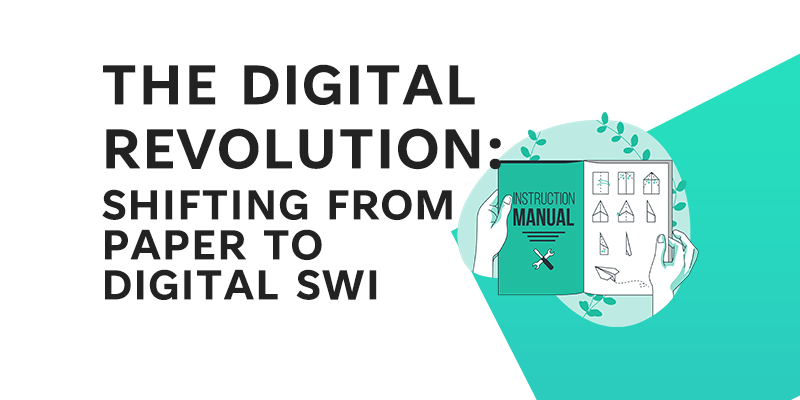In the age of rapid technological advancement, the business world has experienced seismic shifts in how processes and operations are conducted. Standard Work Instructions (SWIs)—detailed guides that ensure consistency and quality in tasks—are at the heart of many industries. Traditionally rooted in paper-based formats, these vital tools once took up physical space, required manual updates, and posed distribution challenges. However, as the digital wave sweeps across industries, there is a transformative shift away from these static sheets and toward dynamic digital platforms. This shift isn’t just about convenience; it’s about leveraging the power of modern technology to transform the very essence of work instructions. Dive in as we investigate the transition of SWIs from paper trails to digital highways.
Table of Contents
The Digital Revolution in the Business World
At the turn of the century, digital technology began to reshape the very fabric of the business landscape. This digital revolution, which cut across industries, transformed how businesses operate, communicate, and provide value to their customers. Businesses around the world are integrating digital tools to optimize processes, improve customer experiences, and foster innovation, from retail adopting e-commerce models to manufacturing leveraging automation.
But this wave of digital transformation isn’t a passing fad; it’s a necessity. Being digitally agile is critical for survival in a world driven by data, connectivity, and real-time decision-making. Companies that resist this shift risk becoming obsolete, with competitors who embrace digital methodologies outpacing them. In essence, the digital revolution is about forging a sustainable future in an ever-changing business ecosystem, not just keeping up with the times.
Limitations of Paper-Based SWIs
Standard Work Instructions (SWIs) have long been the cornerstone of ensuring consistency and accuracy in various industries. However, when these instructions are tethered to paper, several inherent limitations emerge.
- Storage and Accessibility: Paper SWIs demand physical storage space, often leading to bulky filing systems that can become cumbersome over time. Locating a specific instruction manual or document can be time-consuming, especially in larger facilities with extensive procedures. Additionally, paper documents are vulnerable to wear, tear, and loss, compromising their longevity and reliability.
- Difficulty in Updating and Revising: Making changes to paper-based SWIs can be a daunting task. Every revision requires reprinting, redistributing, and ensuring that outdated versions are discarded. This not only consumes time but also introduces the possibility of inconsistencies if some departments or personnel continue using outdated instructions.
- Challenges in Sharing and Distribution: Distributing paper documents across different departments, facilities, or geographical locations can be logistically challenging. It’s labor-intensive, slow, and poses the risk of miscommunication or missed updates.
- Environmental Concerns: The environmental impact of paper production and waste is significant. Relying heavily on paper-based SWIs contributes to deforestation and increases the carbon footprint of an organization. Transitioning to digital alternatives not only streamlines operations but also champions sustainability, reducing waste and conserving resources.
In light of these challenges, the move towards digital SWIs is both a practical and environmentally conscious decision for modern businesses.
The Advent of Digital SWIs
As industries began to recognize the constraints of paper-based Standard Work Instructions, the push towards digital solutions gained momentum. However, this transition wasn’t without its hurdles.
Initial Resistance and Challenges Faced: The introduction of digital SWIs was met with skepticism by many. Employees accustomed to traditional methods were hesitant to embrace new technologies, fearing a steep learning curve or potential job displacement. Additionally, companies grappled with the logistical challenges of migrating vast amounts of data from physical to digital formats, ensuring data security, and investing in the necessary infrastructure and training.
The Shift in Mindset: Overcoming these barriers required a fundamental change in perspective. Forward-thinking companies began to champion the benefits of digital transformation, emphasizing its potential to enhance efficiency, accuracy, and collaboration. As success stories emerged and the tangible benefits of digital SWIs became evident, a broader acceptance began to unfold. The mindset transitioned from viewing digital tools as mere replacements for paper to recognizing them as powerful platforms that could redefine how work instructions were created, shared, and utilized.
Benefits of Digital SWIs

Embracing digital SWIs has unlocked a plethora of advantages for businesses:
Enhanced Accessibility and Storage Capabilities: Digital SWIs eliminate the need for physical storage, making them easily accessible from any device, anywhere, provided there’s internet connectivity. Cloud-based solutions ensure that vast amounts of data can be stored without the constraints of physical space.
Easy Updates and Real-Time Revisions: Changes can be made instantaneously to digital SWIs, ensuring all users access the most recent and accurate version. This real-time updating eliminates the risks associated with outdated or inconsistent instructions.
Integration with Other Digital Tools and Platforms: Digital SWIs can seamlessly integrate with other enterprise software, such as ERP or CRM systems, fostering a more interconnected and streamlined workflow.
Advanced Features: Features like search functions allow users to quickly locate specific instructions. Tagging facilitates categorization, and hyperlinks can connect related documents or external resources, enhancing the user experience and efficiency.
Reduction in Environmental Footprint: Shifting to digital platforms drastically reduces the need for paper, thereby diminishing deforestation and waste associated with paper production and disposal. This move not only promotes operational efficiency but also emphasizes an organization’s commitment to sustainability.
In summary, the transition to digital SWIs symbolizes more than just a technological upgrade; it represents a strategic move towards a more efficient, collaborative, and environmentally responsible future.
Tools and Platforms for Digital SWIs
The shift from traditional paper-based SWIs to digital formats has been facilitated by a range of software and platforms designed specifically to address the needs of modern businesses. These tools not only help in creating digital SWIs but also enhance their utility through various features.
Overview of Popular Software and Platforms:
- Dozuki: A leading platform for creating visual, step-by-step instructions. It’s popular in the manufacturing sector due to its easy-to-use interface and robust features like video integration, real-time feedback, and analytics.
- QT9 QMS: This is more than just a tool for creating SWIs. It’s a complete quality management system that allows businesses to integrate their SWIs with other aspects of quality control, ensuring consistency and compliance.
Features to Look for When Selecting a Tool:
- Intuitive Interface: The tool should be user-friendly, allowing both tech-savvy and less tech-inclined individuals to create, update, and access instructions with ease.
- Multimedia Integration: Modern SWIs often incorporate images, videos, and even interactive elements. A good platform should support such integrations seamlessly.
- Collaboration Features: The ability for multiple users to collaborate in real-time, leave comments, and provide feedback can be invaluable in refining SWIs.
- Version Control: As SWIs get updated, it’s crucial to track changes and maintain a history of previous versions. This ensures that any changes can be reviewed and reverted if necessary.
- Mobile Accessibility: In today’s world, being able to access SWIs on mobile devices on the shop floor or in the field is a significant advantage. Platforms that offer mobile apps or are mobile-responsive are highly desirable.
- Integration Capabilities: The ability to integrate with other enterprise systems, like ERPs, CRMs, or Learning Management Systems, can streamline processes and ensure consistency across the board.
- Security and Compliance: Given the critical nature of SWIs, it’s essential that the platform provides robust security features, including data encryption, user authentication, and compliance with industry standards.
Examples: Consider a manufacturing company using Dozuki. They can incorporate videos showing machinery operations, ensuring workers understand procedures visually. On the other hand, a pharmaceutical company using QT9 QMS might integrate their SWIs with quality audits, ensuring that procedures align with regulatory standards.
In conclusion, the right digital SWI tool can revolutionize the way businesses create, manage, and distribute work instructions. By considering the specific needs of the organization and the features offered by these platforms, companies can make an informed decision that will serve them well into the future.
Overcoming Challenges in the Digital Transition
Transitioning from traditional paper-based SWIs to digital platforms offers numerous advantages, but the shift also comes with its set of challenges.
Addressing Resistance to Change within the Organization: Humans are naturally resistant to change, especially when routines have been established over long periods. To address this resistance:
- Open Communication: Engage with employees to understand their concerns and provide clear reasons for the change, emphasizing the long-term benefits.
- Involving Stakeholders: By involving key stakeholders in the decision-making process, you can gain champions for the cause who can influence their peers.
Training and Educating Employees: The success of digital SWIs largely depends on how comfortably employees can use them.
- Comprehensive Training Programs: Offer hands-on training sessions, workshops, and demonstrations on how to use the new tools.
- Provide Resources: Create user manuals, FAQs, and helplines to assist employees during the transition.
Ensuring Data Security and Privacy: Digital platforms can be vulnerable to cyber threats.
- Invest in Secure Platforms: Opt for SWI platforms that prioritize security features like end-to-end encryption and regular security patches.
- Regular Audits: Periodically assess the system for vulnerabilities and take corrective action promptly.
- Employee Training: Ensure that employees are educated about best practices in cybersecurity to prevent inadvertent breaches.
The Future of Digital SWIs
The evolution of technology promises an even brighter future for digital SWIs.
Potential Integration with Emerging Technologies:
- Augmented Reality (AR): AR can overlay digital instructions on the real world, guiding workers in real-time. For example, a technician wearing AR glasses could see step-by-step instructions superimposed on the machinery they’re repairing.
- Virtual Reality (VR): VR can immerse trainees in a simulated environment, allowing them to practice procedures without real-world consequences. This can be particularly beneficial for high-risk industries.
- Artificial Intelligence (AI): AI can be used to analyze the effectiveness of SWIs, suggest optimizations, and even predict when certain procedures might need updating.
Predictions about how Digital SWIs will Evolve Further:
- Personalized Instructions: Using AI, SWIs might adapt in real-time to the user, offering personalized guidance based on their experience level and past performance.
- Real-time Feedback: With sensors and IoT integration, digital SWIs could provide instant feedback to users, correcting errors on the spot.
- Global Collaboration: Enhanced cloud platforms will allow for real-time collaboration on SWIs from experts worldwide, ensuring a confluence of global best practices.
In the coming years, the convergence of these technologies will not only redefine the structure and delivery of SWIs but also the very nature of training, work execution, and continuous improvement in industries worldwide.
Conclusion
In the swiftly evolving landscape of the 21st century, the transformation of Standard Work Instructions from paper to digital formats represents more than just a technological shift—it signifies an organizational evolution towards efficiency, adaptability, and sustainability. While the journey is fraught with challenges, from resistance to change to cybersecurity concerns, the potential rewards are profound. The integration of emerging technologies like AR, VR, and AI promises to elevate SWIs to unparalleled heights, offering real-time, personalized, and immersive experiences. As industries worldwide strive for excellence and consistency, embracing the digital revolution in SWIs becomes not just an option but a necessity. Organizations that harness this momentum will undoubtedly pave the way for a more streamlined, collaborative, and innovative future.








